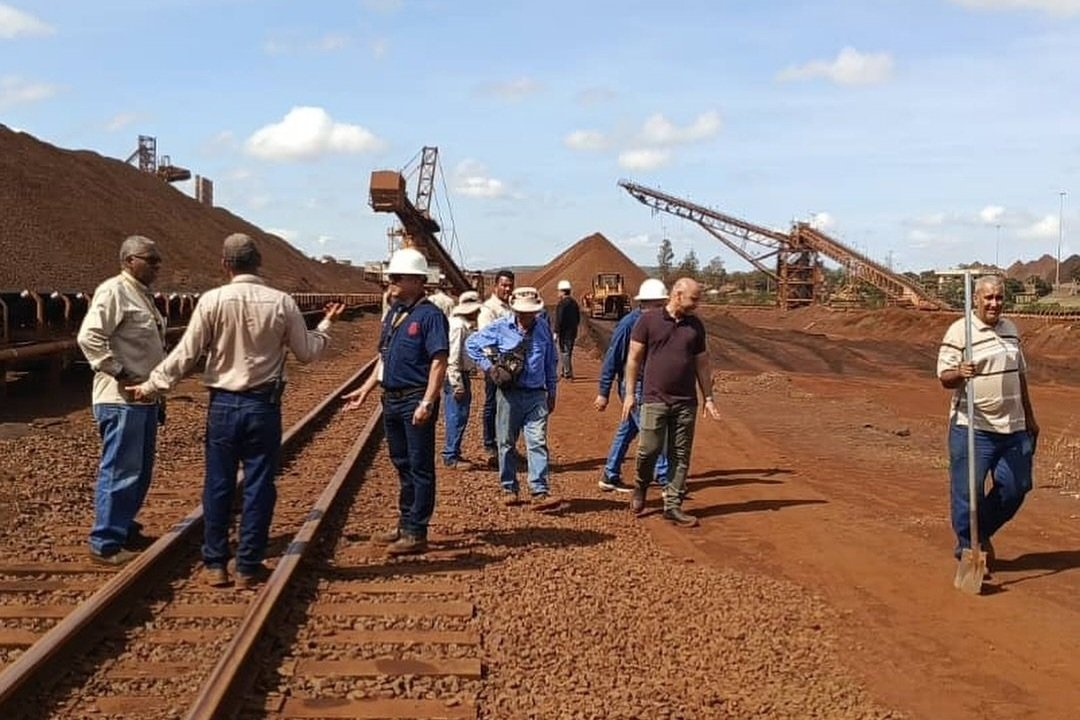Venezuela quietly launches mass privatisation programme
Workers at a Ferrominera Orinoco site. The iron ore company is a subsidiary of the Corporacion Venezolana de Guayana, a state-owned conglomerate dedicated to metals, mining, and lumber based in Bolivar state.
Venezuela would be discreetly launching a mass privatisation programme, according to various sources who claim to have information on the matter.
Alex Saab, who heads both the Ministry of Industry and the foreign investment centre—the CIIP—would be leading this programme.
Last month, Colombian president Gustavo Petro claimed that Saab plans to sell off Monómeros and stated his disagreement, sparking a diplomatic row between Bogotá and Caracas. The Colombia-based fertiliser is a subsidiary of Pequiven, Venezuela’s state-owned petrochemicals company.
Luigi Pisella, from the business association Conindustria, also said that there is a plan to draw private capital in up to 600 state-owned enterprises (SOEs), including the option to privatise assets.
So far, the Venezuelan government has limited options to public-private partnerships or “strategic alliances,” giving investors contracts to use state assets without being able to buy them.
Investors seeking strategic alliances report that they have been offered to buy the assets of interest outright. An investor claimed that the plan is to privatise up to 80% of state-owned assets. These would not include oil, mining, or public services like healthcare and education.
State institutions, including ministries, government agencies, and SOEs reportedly have lists of assets to sell. Lists seen by Orinoco Research include real estate properties: commercial establishments, warehouses, factories, and residential apartments.
Who will invest in Venezuela?
In the last two years, North American and European companies rushed to invest in Venezuela’s oil and gas sector, after Russia invaded Ukraine and with the Biden administration’s flexibilisation of sanctions. They include Chevron, Repsol, Maurel & Prom, Eni, Global Oil, LNG Energy, BP, and Shell.
However, other sectors have drawn up interest from companies based mostly in India, Russia, China, Iran, Turkey and the Arab Gulf monarchies. Their shared profile has been an appetite for risk and political connections.
Recent examples of investments via strategic alliances are Jindal Steel & Power’s deal with Ferrominera del Orinoco to process iron ore, and Iran’s MDC and Turkey’s Sayinlar Group setting up factories in La Guaira Special Economic Zone.
Although economic sectors outside of oil and gold mining are not directly sanctioned by the US Treasury’s OFAC, most top government officials are on the list, including Alex Saab. This means that Western investors will stay clear of Venezuela, unless they have specific licenses like some oil companies do.
Venezuela is also subject to one of the highest country risk ratings, due to issues like political instability, poor property rights and rule of law, and lacking public services.
This could mean that we will see most privatisation buyers coming from the same countries interested in strategic alliances, many of which are US rivals, like Russia, China, and Iran.
From Chavez’s nationalisations to economic liberalisation
Venezuela’s state owns a vast inventory of assets, even if many are paralysed or producing well below their installed capacity. Beyond the country’s vast natural resource reserves, the state can offer hundreds of industrial, agricultural, financial, transport and tourist companies and their assets to private investors.
Notable non-oil SOEs include financials like the Banco de Venezuela, the Banco del Tesoro and the Banco Digital de los Trabajadores; the CVG, a conglomerate that produces iron, bauxite, gold, lumber, as well as steel and aluminium; telecoms company CANTV; and hotels formerly owned by Hilton and other multinational brands.
The Chávez nationalisations
Late President Hugo Chávez embarked on a large programme of nationalisations and expropriations during his tenure, from 1999 to 2013, as part of his plan to turn Venezuela socialist. Estimates are that his government spent around $23 billion on nationalisations, covering virtually all economic sectors. Nationalisations included oil fields, mines, hotels, banks, factories, agricultural land, and transport companies.
After Chávez’s passing President Nicolás Maduro, his successor, has tried to gradually change course. 12 years later, the Venezuelan government would finally be ditching the taboo of privatisation. If this new programme is carried out to its full extent, we could see a monumental transfer of wealth from public to private hands, second only to Russia in the 1990s.
Since 2018, the Maduro government has increasingly taken a path of economic liberalisation, moving away from Chavez’s vision of constructing socialism. Under Delcy Rodriguez, the Finance Ministry brought in former Ecuadorian ministers Patricio Rivera and Fausto Herrera, who took pragmatic measures to bring down inflation and recover some economic growth after years of collapse.
Venezuela also opened up to private investment with the aforementioned strategic alliances and special economic zones, and SOEs sold additional shares into the local stock market. Foreign oil and gas corporations were also given greater financial and operational control, in what was known as the “Chevron model.” However, measures still shied away from outright privatisations, until now.

